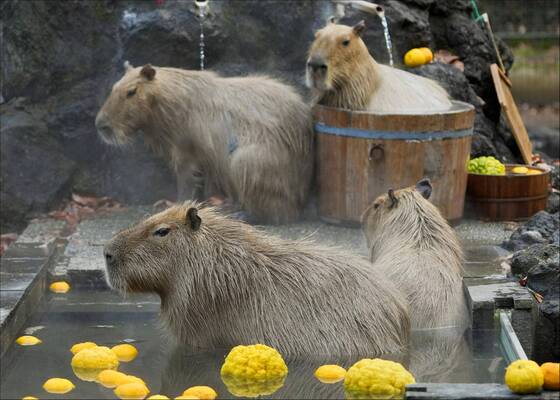Capybara
IUCN
LCBasic Information
Scientific classification
- name:Capybara
- Scientific Name:Hydrochoerus hydrochaeris,Paraguayan capybara, Uruguayan capybara
- Outline:Cetacea
- Family:Rodentia Caviidae Hydrochoerus
Vital signs
- length:106-134 cm
- Weight:35-66kg
- lifetime:6-12 Year
Feature
The largest rodent in the world
Distribution and Habitat
Originally distributed in South America, it mainly inhabits various lowlands close to water, rivers, lakes, tropical rainforests, swamps, brackish wetlands, seasonally flooded grasslands and savannas. Dry grasslands and pastures with a certain amount of moisture are suitable for capybaras to survive.
Appearance
Adult capybaras are 106-134 cm long, 50-62 cm tall at the shoulder, and weigh 35-66 kg, with females slightly larger. Capybaras are the largest rodents in the world, with a stout, barrel-shaped body and a degenerate tail. Capybaras have coarse and sparse hair, ranging from yellow-brown, reddish-brown, dark brown to dark gray on the back, yellow-brown on the belly, and sometimes some black hair on the face, outer edges of the limbs and buttocks. Their lower jaws cannot move vertically, so they can only chew forward and backward. Like other rodents, capybaras' incisors (2 pairs) continue to grow to offset the wear caused by herbivory. Capybaras' hind legs are slightly longer than their front legs, with 3 and 4 toes respectively. Capybaras are good swimmers, with webbed feet like duck feet that help them paddle quickly. Capybaras have blunt snouts, and their eyes, noses and ears are close to the top of their heads, making them more adapted to semi-aquatic life, helping them to b
Details
Although we don’t see capybaras very often, they look very cute and are very friendly to humans. Capybaras like to live in relatively humid places because they cannot live without water. Their cute appearance has also attracted the attention of many people, especially girls, who may like this little animal.

Capybara gives people the feeling of being harmless and "warm". Anyone who sees it wants to give it a comfortable hug. The capybara is indeed the "central air conditioner" in the animal world. Everyone wants to be friends with it. Cats want to rub against it comfortably when they see it, monkeys want to surround it and pet it when they meet it, and even crocodiles can often get along with it in a friendly manner.
But in the cruel natural world, being cute can't save yourself. Capybaras are such docile and cute animals, but they often have to face the threats of predators such as jaguars, pythons and even crocodiles. Capybaras have to rely on their own strength to survive. So under the docile and cute appearance of capybaras, they hide stronger adaptability than any other rodents.
Capybaras are definitely good swimmers among mammals. They move quickly in water or swamps, and crocodiles are often not their opponents. They can even sleep in the water.
Although capybaras are so sturdy, they are as agile on land as in water when escaping. Their short-distance running speed reaches 35 kilometers per hour, which is about the same speed as humans. As long as they can enter the water quickly, they have more chances to escape the pursuit of predators.
In addition to the above advantages, capybaras have a special "secret weapon" - feces. Capybara feces are high in nutrients. Studies have found that it contains 14% to 17% crude protein and a lot of vitamins. It can also serve as a supplementary source of animal intestinal flora. Crocodiles may give up hunting them for these nutrients. Just like the toothpick bird, capybaras often form a symbiotic relationship with crocodiles. Biologists also believe that the reason why capybaras have become the "central air conditioner" of the animal world is not only because they have good tempers, but also because they can provide animals with feces with high nutritional content. For other animals, capybaras are actually mobile snack vending machines.
As early as the 18th century, people loved the fur and meat of capybaras, and people began to hunt capybaras, almost making the animal extinct. Later, as more and more people realized the cuteness of this animal, hunting was banned, and capybaras continued to appear in major zoos around the world, where they became stars, and the entire species quickly got rid of the crisis of extinction.
Listed in the 2008 Red List of Endangered Species of the World Conservation Union (IUCN) ver 3.1-Low Risk (LC).













